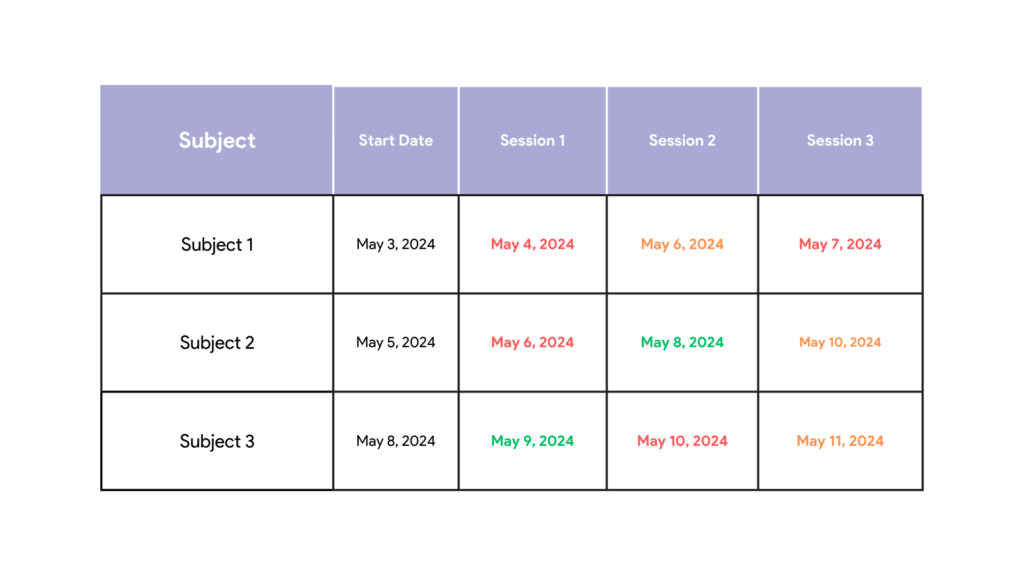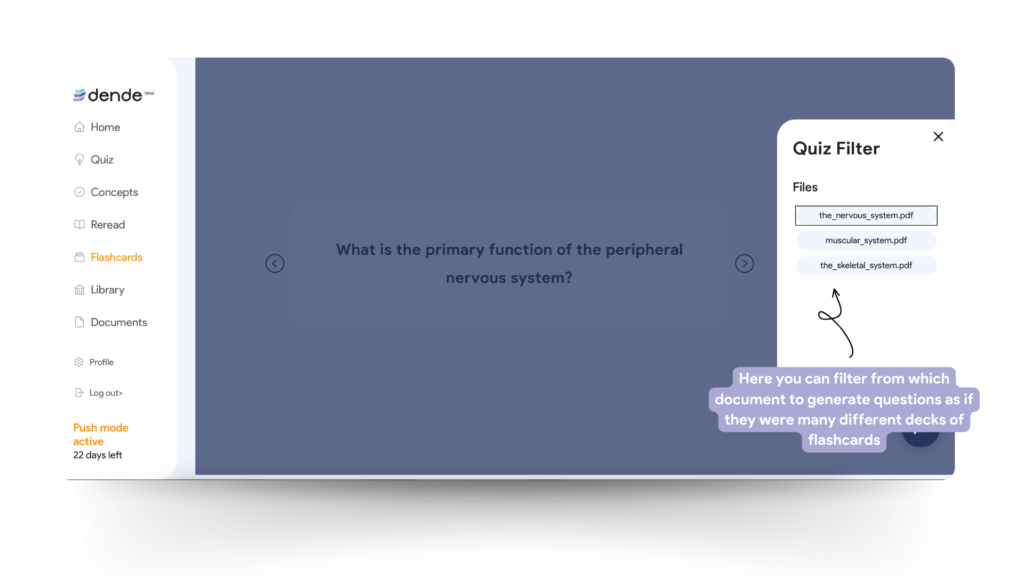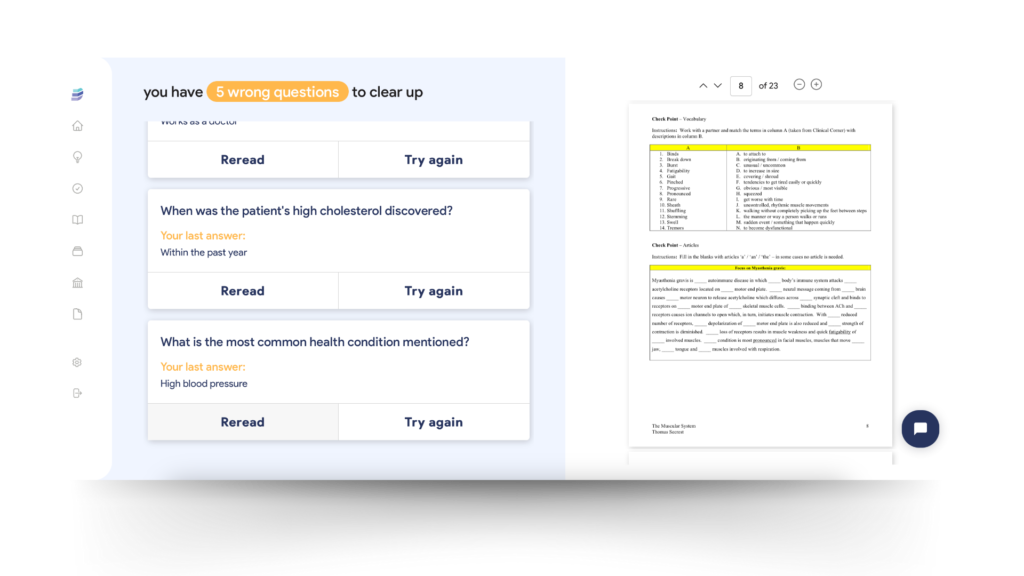
Share with your student friends
ShareGet ready for your next exam
Start for freeWhen you are preparing for a particularly difficult exam, one of the most common challenges is finding effective ways to memorize information over a long period of time. This is where spaced repetition comes in.
In this article I briefly explain what spaced repetition is, but more importantly how to use it in your study plan. You’ll discover how this technique can revolutionize the way you study and memorize information. Let’s go!
Contents
What is spaced repetition
Spaced repetition, as the name suggests, involves spacing out the repetition of a given topic over a certain period of time. Basically, it is the opposite of cramming, a very popular revision strategy.
But, as I think we all know, with cramming the next day you have already forgotten everything. So cramming is not ideal if we want to keep things in long-term memory.
The idea behind spaced repetition is that instead of cramming things into a single day, you spread the review out over time and review the topics, ideally through active recall, at specific intervals.
How to apply spaced repetition to your study plan
To implement spaced repetition in your study plan, one of the key techniques that I have found particularly effective is a spreadsheet system. You can implement it using, for example, Excel or Google Sheets.
First, create a spreadsheet for each subject and then, in the first column of each spreadsheet, list all the topics in that subject.

Basically, whenever you study a topic and, critically, actively recall information from that topic, you write the current date in the column along the spreadsheet.
You cannot mark a date only when you have read a textbook chapter – that would be too passive – but only when you have actively recalled information, facts, quotes or essay projects.
After you have studied other topics and repeated this exercise, start making a list of repetitions you have done. This table allows you to keep track not only of the last time you studied that topic, but coloring each topic according to your understanding, you can also begin to rank how confident you are about each particular topic.
The spreadsheet system is very simple, providing a graphical representation of where you are for each subject and allowing you to more effectively track your daily schedule.
The reason this method works is the so-called forgetting curve. It is something we can probably all experience intuitively. You’ve probably had that feeling where, you know, you review something and then you look at it a week later and you feel like you’ve forgotten everything.
It’s the idea that over time we forget things at an exponential rate.
So, let’s say I studied upper limb anatomy today and then reviewed it tomorrow. I broke the forgetting curve. So whereas before I might have forgotten half of it by tomorrow, now I will only forget 25% of it by the next day. And if I then review it three days later, I’m back to 100%.
Spaced repetition: a practical example

This timetable is designed as an example to help medical students organize their study sessions for various subjects using spaced repetition principles.
Each row in the table represents a different subject that you need to study for an Anatomy exam. The columns include the subject name, the start date for studying that subject, and three subsequent study sessions.
- Name: This column lists the subjects that are typically included in an Anatomy exam;
- Date: This column indicates the start date for the initial study session of each subject.
- Session 1: The first review session after the initial study date. The interval is set based on the retention rate and difficulty of the subject. For example, the Skeletal system has a 1-day interval for the first review.
- Session 2: The second review session, scheduled after an interval from Session 1. The interval is adjusted based on the performance in the previous session. For example, the Muscular System is reviewed again after 4 days from the first session.
- Session 3: The third review session, further spaced out to reinforce long-term retention. The interval for this session varies, with subjects like the Urinary system having a 7-day interval after the second session to ensure the information is committed to long-term memory.
This timetable helps you plan your study plan efficiently, ensuring that each subject is revisited at optimal intervals to maximize retention and understanding.
Flashcards spaced repetition: how it works
When it comes to spaced repetition, flashcards are a must.
Here are some tips for integrating spaced repetition and flashcards:
- Review flashcards at specific, increasing intervals: for example, on Day 1, Day 2, Day 4, Day 8, and so on. Spaced repetition works because it activates long-term memory, while leaving small breaks between studies uses short-term memory.
- Try writing the answer or definition in your own words and giving examples. This will help learning and long-term memory.
- Once you get the right answer with the flashcard, do not discard it! You must keep repeating the question even if you got it right several times, otherwise you will never remember it again.
- On dende create a file for each exam topic. That way you will have several bundles of flashcards, practicing spaced repetition for each topic.

How to use spaced repetition with MCQs test
I recommend that you also apply the spaced repetition technique with multiple-choice quizzes.
This is where dende comes in: questions that appear for the first time or that you have answered incorrectly will be resubmitted to you at increasing intervals, allowing you to review and reinforce knowledge about those specific concepts over time.
In addition, dende’s Reread feature allows you to review the questions you answered incorrectly and directly access the study material to check your answers.
This process not only encourages consolidation of information in long-term memory, but also provides immediate and personalized feedback, helping you identify your gaps.

The “Retry” option also encourages you to practice actively and improve your performance over time.
Remember: it’s not just about memorizing for a test, it’s about building solid, lasting knowledge. Use flashcards, online quizzes, or whatever tools help you practice this technique. And if you need more advice for your study plan, take a look here.
